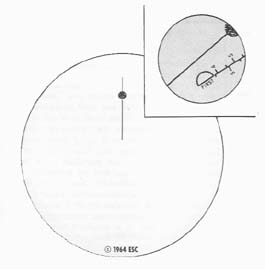THE MOON DISC (C) AND HOW TO READ IT
This disc rotates in the same direction as the Sun Disc, but slower by 50 minutes per day. The phases of the moon, which are imprinted on Sun Disc (D) must therefore be read clockwise. If the moon line on the Moon Disc (C) is between the new moon and the first quarter, it is approaching first quarter. See magnified view at right.
When the moon arrives at its zenith or "south" meridian position its solar time is read by the sun line and its gold hour marks.
For other positions, the light blue hours on the horizon curve on Moon Disc (B) show the number of solar hours before or after the moon's meridian position. Moon rise and set will be evenly spaced relative to this meridian position.

Setting the Moon Disc
Find the time of moonrise (or moonset) from your local paper or from other sources
listed on page 31. (The Sun Disc should have been set as shown on page before.)
1. Use the Brass Thumb Knob on clock motor (which moves all discs) for the purpose of setting the line through the sun (on Sun Disc (D)) to the time of moonrise (or moonset) given in your newspaper.
2. By turning the red knob only, reset the line through the moon (Disc (C)) to the time of sunrise (or sunset if you used moonset).
3. Return all dials to the original or present standard time settings by turning only the Brass Thumb Knob on clock motor.
By ascertaining the time of sunrise and moonrise (or sunset and moonset) from the newspaper, you set the moon relative to the sun. The 3-step setting procedure given below is necessary because the space interval between sun's position and moon's position is not constant.
Therefore, you must use the particular time of sunrise and moonrise (or sunset and moonset) given in the newspaper, in order to set the moon correctly relative to the sun. At any other time settings, the positions of the two would be different and incorrect.
EXAMPLE
If your newspaper reports that the sun is to rise at 5:28 a.m., and the moon is to rise at 6:49 p.m., you first set the line through the sun at the time of moonrise, 18:49 hours (=6:49 p.m. + 12). This is done, as previously explained by turning only the Brass Thumb Knob No. 7.
You have previously set the line through the sun, at real sun time (seepage ) and now are changing it only in order to make a correct relative setting of the moon disc.
Now set the moon at the time given for sunrise. This position, corresponding to the hour of sunrise, is the effective horizon for both sun and moon for that day. To continue our example, set the line through the moon at 6: 28 hours.
The next step is to reset the clock by turning only the Brass Thumb Knob. This automatically resets all the dials in their proper relationship.
USE THE SPACE PROVIDED BELOW TO NOTE YOUR SETTING FIGURES
DATE:
RISE OR SET
Time of Moon:
(plus 12 hours if it is occurring in the p.m.) is the time at which you will position your sun line)
Time of Sun:
and time at which you will position your moon line:
Remember that you will be reading the position of the moon in terms of solar time. If you find it more practical for your purposes to know this in standard time, use your standard- to -solar conversion factor in reverse fashion. This conversion, you will recall, is explained in detail.
More pictures of Spilhaus Space Clock and how to repair it.
